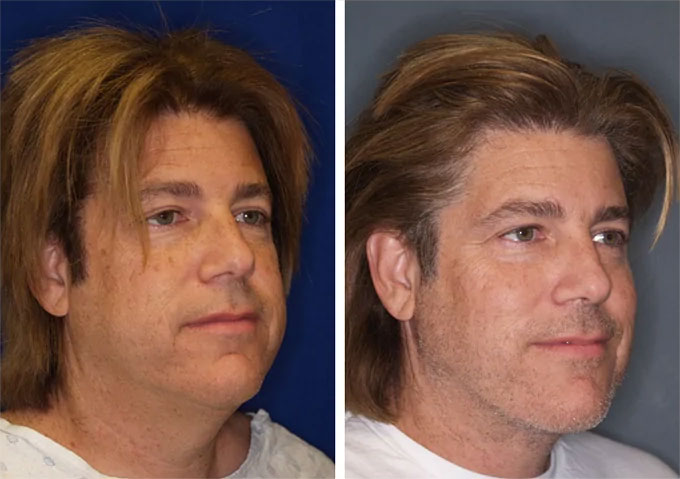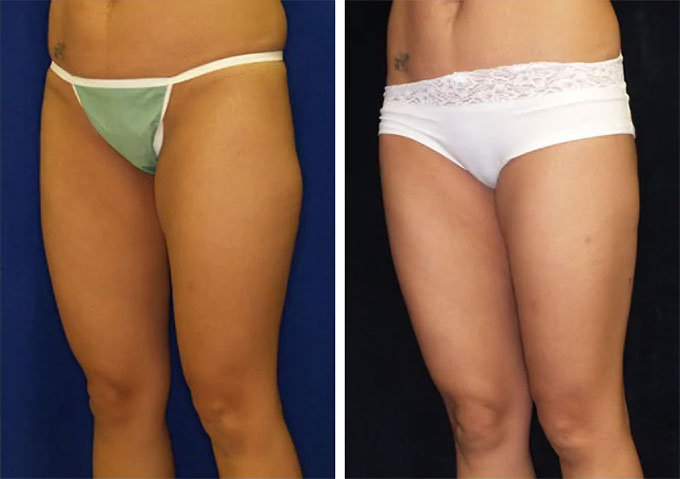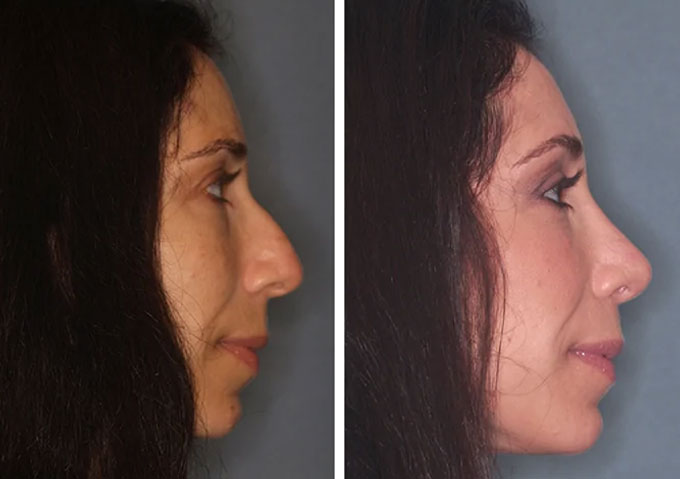Breast Reduction in Beverly Hills
Patients who undergo breast reduction surgery are either seeking relief from physical symptoms caused by excessive weight of large breasts or desire to have smaller, more proportionate and lifted breasts. Breast reduction surgery may be able solve these problems, possibly making your breasts lighter and more comfortable; allowing clothes to fit better.
Insurance Coverage for Breast Reduction Surgery
Insurance coverage is sometimes available for breast reduction surgery. Many factors determine your eligibility, including the specific terms of your insurance policy and the amount of breast tissue to be removed. A letter of predetermination may be required by your insurance company prior to surgery. Although insurance coverage is still available for this procedure, Dr. Minniti no longer accepts this insurance.
Surgical Techniques for Breast Reduction
The most common method of reducing the breasts involves three incisions: one around the areola, one that runs vertically from the areola to the bottom of the breast at its crease, and one that runs along the crease.
After Dr. Minniti reduces excess breast tissue, fat, and skin, the nipple and areola are shifted to a higher position, and the areola is usually reduced in size. The nipple and areola usually remain attached to the underlying tissue, preserving the sensation. The ability to breastfeed may also be preserved, but this cannot be guaranteed. Liposuction may also be used to improve the contour of the breast near the armpit and side of the chest.
There are many variations to the design of the incisions for breast reduction. The size and shape of your breasts as well as the desired amount of reduction are factors that will help Dr. Minniti determine the best technique for you.
Comprehensive Evaluation for Breast Reduction
You may be a good candidate for breast reduction surgery if you have one or more of the following conditions:
- Breasts that are too large in proportion to your body
- Heavy, pendulous breasts with nipples and areolas that point downward
- One breast is much larger than the other
- Back, neck or shoulder pain caused by the weight of your breasts
- Skin irritation beneath your breasts
- Indentations in your shoulders from tight bra straps
- Restriction of physical activity due to the size and weight of your breasts
- Self consciousness about the large size of your breasts
Breast reductions can be performed at any age, but plastic surgeons usually recommend waiting until breast development has stopped. Childbirth and breastfeeding may have significant and unpredictable effects on the size and shape of your breasts. Many women, however, decide to undergo breast reduction before having children and feel they can address any subsequent changes later. During your consultation, you will be asked about your desired breast size as well as anything else about your breasts that you would like to see improved. This will help Dr. Minniti to understand your expectations and determine whether they realistically can be achieved.
You should come prepared to discuss your medical history. This will include information about any medical conditions, drug allergies, medical treatments you have received, previous surgeries, and medications that you currently take. You should tell Dr. Minniti if you plan to lose a significant amount of weight, particularly if you have noticed that your breasts become smaller with weight loss. Dr. Minniti will examine your breasts, taking measurements and photographs. The size and shape of your breasts, the quality of your skin, and the placement of your nipples and areolas will be carefully evaluated.
Schedule Your Breast Reduction Consultation Today
If overly large or heavy breasts are impacting your comfort or confidence, breast reduction surgery may be the solution. Dr. Minniti provides expert, compassionate care tailored to your unique goals. Contact our Beverly Hills office today to schedule your breast reduction consultation and take the first step toward feeling more balanced, confident, and comfortable.
Learn More
Preparing for Your Breast Reduction Procedure
Risks & Complications
Fortunately, significant complications from breast reduction are infrequent. Every year, thousands of women undergo successful breast reduction surgery, experience no major problems and are pleased with the results. *
*Individual results may vary
Some of the potential complications that may be discussed with you include bleeding, infection and reactions to anesthesia. Following reduction, sometimes the breasts may not be perfectly symmetrical or the nipple height may vary slightly. Minor adjustments can be made at a later time, if desired. Loss of sensation in the nipples or breasts may occur. Incisions that have healed poorly may be revised as well. In the event of injury to or loss of the nipple and areola, they can possibly be satisfactorily reconstructed using skin grafts.
Preparation For Surgery
Depending on your age, or if you have a history of breast cancer in your family, Dr. Minniti may recommend a baseline mammogram before surgery and another mammographic examination six to twelve months after surgery. This will help to detect any future changes in your breast tissue. Following breast reduction surgery, you will be able to perform breast self-examination.
If you are a smoker, you will be asked to stop smoking well in advance of surgery. Aspirin and other anti-inflammatory drugs can cause increased bleeding, so you should avoid taking these medications for a period of time before surgery. Dr. Minniti will provide you with additional pre-operative instructions.
Breast reduction surgery will be performed on an outpatient basis. You will need someone to drive you home and stay with you overnight and the next day to drive you to Dr. Minniti’s office. Alternatively, there are aftercare facilities available that specialize in the care of plastic surgery patients for one or more days after their surgery. These facilities are operated inside hotels located nearby the surgery center, and staffed by registered nurses.
Surgery
The goal of Dr. Minniti and his entire staff is to make your surgical experience as easy and comfortable for you as possible.
Your surgery will be performed in a fully accredited outpatient surgery center in the same building as Dr. Minniti’s office. A general anesthetic is administered, so that you sleep throughout the procedure. Afterward, you will be taken into a recovery area where you will continue to be closely monitored for about an hour. You will be in a snug compressive elastic wrap. After you are awake and comfortable, you will be discharged by the nurse and allowed to go home or to an aftercare facility.
Recovery
On the day of your surgery, you may feel fairly comfortable. You might possibly experience only minor discomfort, usually described as pressure. You will be encouraged to get out of bed for short periods of time. The following day, you will be seen by Dr. Minniti and he will examine you. There will be tape over your incisions that will remain until the following week. You will be instructed to avoid straining, bending, and lifting for a few weeks, and to sleep on your back to avoid pressure on your breasts.
There may be no stitches, but the tape over the incisions will be changed on a regular basis for about four weeks. You may notice that you feel less sensation in the nipple and areola areas. This can be temporary, but it may take weeks, months, or even a year before normal sensation returns. Your breasts will possibly have some discoloration that may last for a few weeks. It might take some time for the breasts to take a more natural shape. The incisions can initially be pink or red in color, but their appearance will fade with time. After breast reduction surgery, it may be possible to return to work within a few days to a week, depending on your job. You may possibly resume normal activities, including exercise, in a few weeks. You may experience mild discomfort occasionally during this recovery period. Care must be taken to be gentle with your breasts for four to six weeks.
Breast Reduction Results
Breast reduction surgery can make your breasts firmer and smaller. The incisions from your surgery can heal and fade over time. It is important to realize, however, that the incision lines may be visible, more so in some individuals than others. Fortunately, the incisions can be in locations easily concealed by clothing, even low-cut necklines. A breast reduction can make a dramatic change in your appearance, for this reason, it may take some time to adjust to your new body image. You may, however, eventually become comfortable with your smaller breasts.
Unless you gain or lose a significant amount of weight or become pregnant, your breast size may remain fairly constant. However, gravity and the effects of aging can eventually alter the size and shape of virtually every woman’s breasts. If you become dissatisfied with the appearance of your breasts after a period of years, you may choose to undergo a breast lift and/or breast augmentation to restore their more youthful contour. Feel free to look at the before and after photos of our breast reduction patients!
You will return to Dr. Minniti’s office for follow-up care at prescribed intervals, at which time your progress will be evaluated. Once the immediate postoperative follow-up is complete, you will be encouraged to return periodically to observe and discuss the long-term results of your surgery.
See Dr. Minniti’s Before & After Breast Reduction Photos.
Related Procedures
Breast Revision
Patients have the opportunity to correct any problems that may have resulted from a previous breast enlargement surgery.
Breast Lift
A breast lift raises and firms the breasts, enhancing their shape and position for a more youthful contour.
Breast Augmentation
Breast augmentation is the one of most common and desired plastic surgery procedures today.
Before & Afters
Patient Gallery



